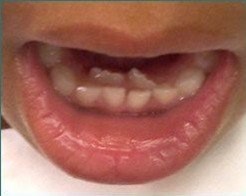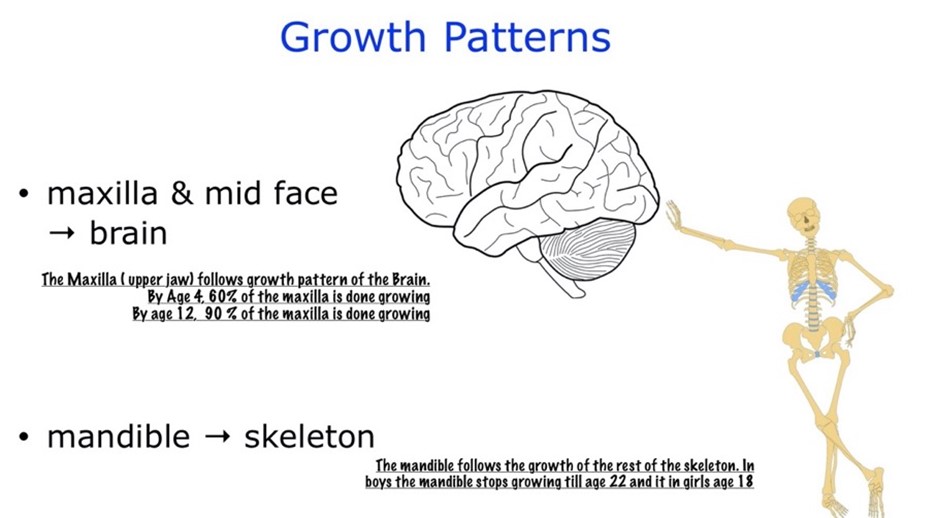Don’t Wait — Early Treatment Is Critical
A Proactive Philosophy
When children are young, their bodies are able to adjust and mold easily, particularly in their mouths and their bone structure. Crowded teeth may force the tongue forward against their teeth, narrowing their dental arch and constricting the airway, which causes them to be unable to breathe properly through their nose. When your jaw is not aligning correctly, it also affects the face. We often see eyes that are not at the same height. We see one ear sticks out and the other does not. We can see that one side of the face is tighter than other side, affecting the jaw joint and facial tension.

Many parents ask us when the right time is to start thinking about orthodontic treatment for their children. At Arlington Smile Center, we start our evaluation of your children’s dental alignment and oral habits at age 3 years and monitor closely every six months. A common approach to teeth straightening is to wait until children are mature enough to handle the responsibility. Dr. Roca used to feel this way. But now, we’ve seen how a proactive approach can lead to far better long-term results. Thanks to a lot of research and many classes, Dr. Roca discovered that one can prepare the mouth to receive the permanent teeth by giving them enough room to erupt. At Arlington Smile Center, we never want to wait until the child turns 7 years old. If Dr. Roca sees a child as young as 3 years old developing a malocclusion or myriad other concerns, such as mouth breathing, snoring, grinding, hanging out with their mouth open or tongue thrusting, or if she detects a tongue-tie or lip-tie, she will highly recommend the child learn the correct habits for proper muscle development. This will enable ideal facial development before the permanent teeth come in, normally around age 5 or 6 years. By starting early, you are allowing room for the developing teeth that are growing under the baby teeth to spread out in the jaw. Since permanent teeth grow directly under the baby teeth, if the baby teeth are spread out, the permanent teeth will be spread out as well to erupt in a non- crowded position.
If you see a child with no space between their baby teeth or if you see a child with crooked teeth, a deep bite or overbite and or a gummy smile, please understand this NEVER gets better. It does not miraculously correct itself. Watching it or waiting till they are older is not the answer, the earlier we fix it the easier while their bone is still malleable. Research has proven that crooked teeth is only 5% genetic and 95% environmental so if you do not correct the environment at a young age the effect on their oral health has a domino effect.
https://onezero.medium.com/our-skulls-are-out-evolving-us-and-that-could-mean-a-public-health-crisis
- Creating room for crowded, erupting teeth
- Creating facial symmetry
- Reducing the risk of trauma to protruding front teeth
- Preserving space for unerupted teeth
- Reducing the need for tooth removal
- Reducing the need for future orthodontic treatment
- Increasing space for nose breathing and airway space, which opens up myriad improvements in medical health

When the permanent tooth erupts behind the baby tooth, we will usually remove the baby tooth.
When it comes to orthodontic treatment, there are more options than braces. Traditional fixed braces take a mechanical approach to straightening teeth, which great importance given to a predetermined cosmetic outcome. Little or no attention is given to creating harmony between the teeth and bite and the individual as a whole. Rather than maintaining this narrow focus on teeth, integrative orthodontics recognize the mouth as part of a complete system, and focus treatment on stability, function and natural beauty instead of only on aesthetic appearances.
What are potential problems with conventional orthodontic treatment?
Conventional braces and orthodontic appliances do not address underlying causes for missed teeth. For example:
- They do not take into account the fact that for most people, one side of our body is more flexible than the other. This discrepancy in flexibility can create strain patterns as early as when a baby is in utero. These strains become aggravated during birth and may be further altered by accidents. Traditional orthodontic treatment is likely to drive patients further into these pre-existing strain patterns and negatively impact their health.
- The narrow focus on cosmetics often leads to some teeth being retracted, and may require some teeth to be extracted from the mouth. This reduces the space for the tongue and alters facial growth and features unfavorably.
- The importance of the airway is not recognized. It takes ORTHOPEDIC changes (affecting bones) to move the maxilla FORWARD. If this forward movement doesn’t happen the tongue is displaced and the airway narrowed, leading to mouth breathing and a head-forward posture. This leads to snoring, sleep disordered breathing, obstructive sleep apnea and TMJ disorders.
- Treatment with full braces typically begins around age 12, after the permanent teeth have erupted. By then, the golden opportunity for correcting underlying problems has passed, which involves using growth to create a solid functional matrix for lasting results. That is why results achieved with full braces need to be maintained by retainers.
What are some of the causes for misaligned teeth?
- Nutritional deficits: Modern diets contain processed and otherwise adulterated foods, and food intolerances only add to the problem. Nutritional and dietary deficiencies as well as parents’ eating habits prior to conception affect jaw and teeth alignment. modern diet contains processed and otherwise adulterated foods which do not help us to thrive.
- Oral posture: The position of the tongue (resting up against the palate, sitting in between the teeth, or close to the floor of the mouth), whether the lips are together at rest, and whether breathing occurs through the nose or the mouth all influence the teeth and jaws.
- Cranial strains: Stresses and tensions in the head and neck area express themselves throughout the body and are reflected in misalignment of the teeth.
- Inadequate Airway: Mechanical obstructions, allergies, an underdeveloped maxilla and mouth breathing can all take a toll on oral and overall health, including the teeth and jaws.
Why start treatment at a young age?
Growth is our biggest ally during orthodontic treatment when our goals are to help a child develop its full potential and to create stable results. When a child has early signs of crowded teeth, poor facial development will occur. The expectation that the child will “grow out” of its dental problems during the teenage years is unlikely to come true for the following reasons:
- The maxilla follows the growth pattern of the brain:
- By age 4, the facial skeleton has reached 60% of its adult size
- By age 12, 90% of growth has occurred
WHEREAS
- The mandible follows the development of the extremities which means growth in females until the age of ~18, in males until ~ 20 or 22.
Since the width and position of the upper jaw determine how much the lower jaw can grow forward, treatment initiated after age 11 has only a limited impact on the maxillary position, has less long-term stability, and a higher degree of complexity.
As early as age four, you can tell whether your child will need help with jaw growth and development. Here are the telltale signs:
- No gaps between the primary front teeth
- The permanent incisors are about 5 mm wider than their predecessors. Unless the baby teeth are aligned like a picket fence, with spacing in between, the permanent teeth will erupt rotated or out-of-place.
- The occlusion exhibits a crossbite
- The maxillary teeth are supposed to align outside of the lower teeth when biting down. If this is reversed facial development is negatively affected.
- Your child is breathing through their mouth instead of through their nose.
- Habitual mouth breathing sets up a vicious cycle leading to poor facial development, airway restrictions and misaligned teeth.
- Swallowing seems laborious for your child due to the recruitment of many facial muscles.
- Snoring, as well as clenching and grinding, are indicative of cranial strains and airway problems.
- Pain symptoms like headaches, migraines, or neck and shoulder pain can originate in underdeveloped jaws and inadequate tongue space.
- As permanent teeth erupt, watch out for
- Crowding and teeth rotations
- Extremes of incisal alignment
- The upper incisors should slightly overlap with the lower ones; the lower ones should be touching the upper ones.

Call us at 703-237-7622 to schedule a visit and determine how your child could benefit from orthodontic care.
